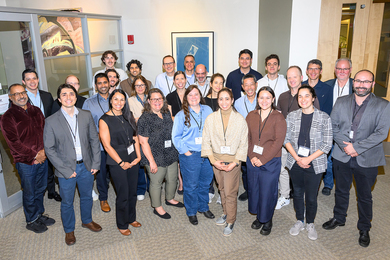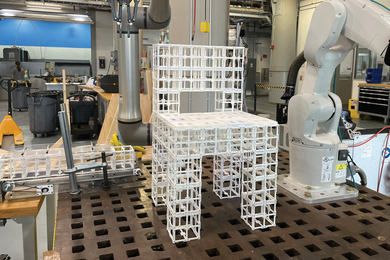As the United States seeks to reinvigorate its job market and move past economic recession, MIT News examines manufacturing’s role in the country’s economic future through this series on work at the Institute around manufacturing.
For millions of HIV-positive people in the developing world, accurate measurement of their medical condition is invaluable. So in recent years, Daktari Diagnostics, a Cambridge-based startup, has been developing a small, mobile diagnostic device that it believes can perform effective cell counts on such patients.
But like a lot of startups, Daktari has faced manufacturing hurdles. In particular, Daktari had to find the best way of mass-producing devices that include a pair of electrodes about 100 microns wide — roughly the width of a hair — on a plastic backing, with another hair’s width in between them.
To solve the problem, Daktari turned, in part, to MIT graduate students pursuing a distinctive degree: the master of engineering in manufacturing (MEngM), an educational track pursued by students who want to solve complex manufacturing problems — and which gives them hands-on experience through group projects in industry settings.
In 2010, a pair of MIT students evaluated Daktari’s production issues; in 2011, three more MIT students from the MEngM program further developed a new way of integrating the sensitive electrodes into the devices, under the supervision of an MIT adviser and Daktari’s management.
“It was the most expensive and fragile part of our system when they started last January, and by the time they left in September, it was the least expensive, most robust component of the system, and that was really a tribute to their work,” says William Rodriguez, Daktari’s CEO.
Now the company is capable of producing thousands of devices per week, hopes to have its product on the market in 2013 and is even building its own production facility in Cambridge. The MEngM program, Rodriguez emphasizes, has been a key part of his company’s progress. “We have enough mentorship to provide students with insight into the real world of manufacturing,” he says, “and we feel the program offers tremendous value by bringing really strong people to us.”
‘An experiment in engineering education’
The collaboration between Daktari and MIT students may have been an unusually extensive one — but then, the designers of the MEngM program say their intention has been to try something different.
“It’s a new experiment in engineering education,” says David Hardt, the Ralph E. and Eloise F. Cross Professor of Mechanical Engineering, professor of engineering systems, and a co-founder of the MEngM program. The program began in 2001 as part of the MIT-Singapore Alliance, and then became a formal degree granted by MIT in 2006.
Students move through the MEngM program, offered by MIT’s Department of Mechanical Engineering, in a unified cohort of about 12 to 25 per academic year. They all take the same eight classes on manufacturing — four per semester — and then undertake industry-based group projects, working for companies ranging from multinational firms tweaking their existing operations to startups such as Daktari that must figure out how to produce goods for the first time.
“The group project is like an engineering residency,” says Brian Anthony, director of the MEngM program and a research scientist in MIT’s Laboratory for Manufacturing and Productivity (LMP). “The students are still in school, but they’re spending time in a workplace, learning the practical side and collaborating with people who are already out there in industry.” Anthony was the MIT adviser helping to oversee the students working with Daktari.
The MEngM program features a highly competitive application process in which MEngM faculty closely examine academic credentials and statements of purpose, and conduct individual interviews with prospective students from around the world. The goal of the program is to address what many industry leaders describe as a chronic shortage of skilled engineers who can help launch new firms or step into a manufacturer’s workplace and improve its practices — a significant issue for the economy as a whole.
“These students are filling an important need in society,” says Hardt, who started the program along with Jung-Hoon Chun, a mechanical engineering professor and LMP director. “There is a gap in general when it comes to students who are ready for industry, and can combine an engineering education with practical experience.”
Thinking systematically
One characteristic of the MEngM program is its focus on systems theory, an area of intellectual inquiry with deep roots at MIT. Systems thinking emphasizes the often nonlinear relationships among different components of a business or society; in manufacturing, a small glitch in a factory can cascade into a large problem for a business.
“Unless your job is controlling one machine, you need to think of a manufacturing enterprise as a complete system at work — whether it’s the system of logistics in the supply chain or in a factory — that lets a product ends up in the hands of the customer,” Anthony says. “And if you haven’t been exposed to systems, you can’t wrap your head around them.”
The MEngM program also includes courses on management issues, product design, and a seminar in which faculty and visiting business leaders discuss key topics with students.
The group project is then the basis for each student’s master’s thesis; Anthony works with companies to develop group projects that are timely for those manufacturers, satisfy the intellectual goals of the program and address the professional aims of students. Companies that have opened up their workplaces to MIT students in the recent past include Daktari, the energy-technology firm Schlumberger, the materials-testing firm Instron and the health-care manufacturer Medtronic.
The group project “helped a lot,” says Sivesh Selvakumar MEngM ’10, especially in terms of “how engineering is practiced in the workplace and how different deadlines and responsibilities are when you’re in a company.” Selvakumar, who now works for St. Jude Medical, Inc., in California, helping to produce pacemakers, also says he benefited from the “breadth of material” in the MEngM courses, “ranging from the nitty-gritty of manufacturing technology, systems and control” to the business side of the industry.
Selvakumar comes from a “family of engineers,” as he puts it, in a small town in southern India. As an undergraduate, he recounts, “the interaction between product design and manufacturing began to interest me more.” Before long, Selvakumar had begun to focus on manufacturing more specifically, and found the MEngM program a logical place for his graduate studies.
The medical-devices field, where he works, is one common destination for MEngM alumni, although among the 150 graduates of the MEngM program since 2006, the most common employers so far have been Apple, Hewlett-Packard, Schlumberger and Proctor & Gamble.
MEngM students such as Selvakumar seem increasingly interested in the problems of turning creative industrial designs into mass-market consumer goods. As Anthony puts it, these students are “interested in product realization, understanding how to take a design and have it be manufactured and make money.”
Other graduates of the MEngM program have gone on to pursue further graduate work, including PhDs in engineering and systems theory. There is not one definitive post-graduation track for students, although virtually all MEngM graduates take seriously the idea that developing new forms of manufacturing is a key part of creating global economic growth in the decades ahead.
“They’re aware before they leave here that this is an issue of importance to every nation,” Hardt says.
Plenty of uncertainty surrounds the long-term global future of manufacturing. For now, in any case, the firms that have worked with the MEngM program say they certainly would like to keep their doors open to its students.
“We’ll stay with it for as long as they’ll keep having us as a partner,” Rodriguez says.
For millions of HIV-positive people in the developing world, accurate measurement of their medical condition is invaluable. So in recent years, Daktari Diagnostics, a Cambridge-based startup, has been developing a small, mobile diagnostic device that it believes can perform effective cell counts on such patients.
But like a lot of startups, Daktari has faced manufacturing hurdles. In particular, Daktari had to find the best way of mass-producing devices that include a pair of electrodes about 100 microns wide — roughly the width of a hair — on a plastic backing, with another hair’s width in between them.
To solve the problem, Daktari turned, in part, to MIT graduate students pursuing a distinctive degree: the master of engineering in manufacturing (MEngM), an educational track pursued by students who want to solve complex manufacturing problems — and which gives them hands-on experience through group projects in industry settings.
In 2010, a pair of MIT students evaluated Daktari’s production issues; in 2011, three more MIT students from the MEngM program further developed a new way of integrating the sensitive electrodes into the devices, under the supervision of an MIT adviser and Daktari’s management.
“It was the most expensive and fragile part of our system when they started last January, and by the time they left in September, it was the least expensive, most robust component of the system, and that was really a tribute to their work,” says William Rodriguez, Daktari’s CEO.
Now the company is capable of producing thousands of devices per week, hopes to have its product on the market in 2013 and is even building its own production facility in Cambridge. The MEngM program, Rodriguez emphasizes, has been a key part of his company’s progress. “We have enough mentorship to provide students with insight into the real world of manufacturing,” he says, “and we feel the program offers tremendous value by bringing really strong people to us.”
‘An experiment in engineering education’
The collaboration between Daktari and MIT students may have been an unusually extensive one — but then, the designers of the MEngM program say their intention has been to try something different.
“It’s a new experiment in engineering education,” says David Hardt, the Ralph E. and Eloise F. Cross Professor of Mechanical Engineering, professor of engineering systems, and a co-founder of the MEngM program. The program began in 2001 as part of the MIT-Singapore Alliance, and then became a formal degree granted by MIT in 2006.
Students move through the MEngM program, offered by MIT’s Department of Mechanical Engineering, in a unified cohort of about 12 to 25 per academic year. They all take the same eight classes on manufacturing — four per semester — and then undertake industry-based group projects, working for companies ranging from multinational firms tweaking their existing operations to startups such as Daktari that must figure out how to produce goods for the first time.
“The group project is like an engineering residency,” says Brian Anthony, director of the MEngM program and a research scientist in MIT’s Laboratory for Manufacturing and Productivity (LMP). “The students are still in school, but they’re spending time in a workplace, learning the practical side and collaborating with people who are already out there in industry.” Anthony was the MIT adviser helping to oversee the students working with Daktari.
The MEngM program features a highly competitive application process in which MEngM faculty closely examine academic credentials and statements of purpose, and conduct individual interviews with prospective students from around the world. The goal of the program is to address what many industry leaders describe as a chronic shortage of skilled engineers who can help launch new firms or step into a manufacturer’s workplace and improve its practices — a significant issue for the economy as a whole.
“These students are filling an important need in society,” says Hardt, who started the program along with Jung-Hoon Chun, a mechanical engineering professor and LMP director. “There is a gap in general when it comes to students who are ready for industry, and can combine an engineering education with practical experience.”
Thinking systematically
One characteristic of the MEngM program is its focus on systems theory, an area of intellectual inquiry with deep roots at MIT. Systems thinking emphasizes the often nonlinear relationships among different components of a business or society; in manufacturing, a small glitch in a factory can cascade into a large problem for a business.
“Unless your job is controlling one machine, you need to think of a manufacturing enterprise as a complete system at work — whether it’s the system of logistics in the supply chain or in a factory — that lets a product ends up in the hands of the customer,” Anthony says. “And if you haven’t been exposed to systems, you can’t wrap your head around them.”
The MEngM program also includes courses on management issues, product design, and a seminar in which faculty and visiting business leaders discuss key topics with students.
The group project is then the basis for each student’s master’s thesis; Anthony works with companies to develop group projects that are timely for those manufacturers, satisfy the intellectual goals of the program and address the professional aims of students. Companies that have opened up their workplaces to MIT students in the recent past include Daktari, the energy-technology firm Schlumberger, the materials-testing firm Instron and the health-care manufacturer Medtronic.
The group project “helped a lot,” says Sivesh Selvakumar MEngM ’10, especially in terms of “how engineering is practiced in the workplace and how different deadlines and responsibilities are when you’re in a company.” Selvakumar, who now works for St. Jude Medical, Inc., in California, helping to produce pacemakers, also says he benefited from the “breadth of material” in the MEngM courses, “ranging from the nitty-gritty of manufacturing technology, systems and control” to the business side of the industry.
Selvakumar comes from a “family of engineers,” as he puts it, in a small town in southern India. As an undergraduate, he recounts, “the interaction between product design and manufacturing began to interest me more.” Before long, Selvakumar had begun to focus on manufacturing more specifically, and found the MEngM program a logical place for his graduate studies.
The medical-devices field, where he works, is one common destination for MEngM alumni, although among the 150 graduates of the MEngM program since 2006, the most common employers so far have been Apple, Hewlett-Packard, Schlumberger and Proctor & Gamble.
MEngM students such as Selvakumar seem increasingly interested in the problems of turning creative industrial designs into mass-market consumer goods. As Anthony puts it, these students are “interested in product realization, understanding how to take a design and have it be manufactured and make money.”
Other graduates of the MEngM program have gone on to pursue further graduate work, including PhDs in engineering and systems theory. There is not one definitive post-graduation track for students, although virtually all MEngM graduates take seriously the idea that developing new forms of manufacturing is a key part of creating global economic growth in the decades ahead.
“They’re aware before they leave here that this is an issue of importance to every nation,” Hardt says.
Plenty of uncertainty surrounds the long-term global future of manufacturing. For now, in any case, the firms that have worked with the MEngM program say they certainly would like to keep their doors open to its students.
“We’ll stay with it for as long as they’ll keep having us as a partner,” Rodriguez says.






